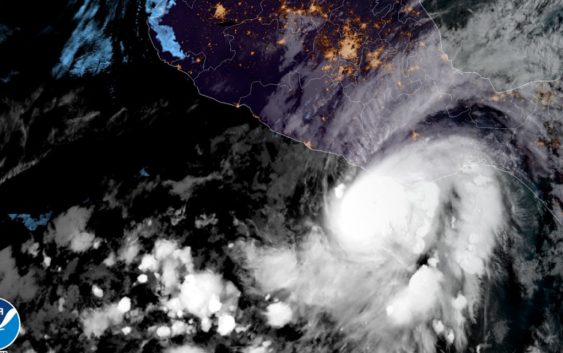- Fake job seekers are flooding the market, thanks to AI
- One set of evacuation orders lifted in Caldwell County after wildfire contained
- 'We gutted every building' | Chimney Rock rebuilding after Hurricane Helene
- 'We gutted every building' | Chimney Rock rebuilding after Hurricane Helene
- Debris from Hurricane Helene provides fuel, complicates containment for spring wildfires
Pacific season's 1st hurricane aims at Mexico tourist zone

Agatha is expected to be the strongest hurricane on record to make landfall in May in the eastern Pacific.
Bands of rain and gusty winds lashed Mexico’s southern Pacific coast Monday as the first hurricane of the eastern Pacific season advanced slowly toward a stretch of tourist beaches and fishing towns.
Ominous grey skies and blowing sand cleared beaches in the popular destinations of Puerto Escondido, Puerto Angel and Huatulco.
Near Puerto Angel, gusts of wind, heavy rain and big waves began lashing the beach town of Zipolite, long known for its clothing-optional beach and bohemian vibe.
“There is a lot of rain and sudden gusts of strong wind,” said Silvia Ranfagni, the manager of Zipolite’s Casa Kalmar hotel. “The ocean is really stirred up, and it’s raining a lot,” said Ranfagni, who has decided to ride out Agatha at the property.
National emergency officials said they had assembled a task force of more than 9,300 people for the area and more than 200 shelters were opened as forecasters warned of dangerous storm surge and flooding from heavy rains.
After forming on Sunday, Agatha quickly gained power, and it was predicted to make landfall as a strong Category 2 hurricane Monday afternoon or evening, the U.S. National Hurricane Center said.
Agatha will be the strongest hurricane on record to make landfall in May in the eastern Pacific, said Jeff Masters, meteorologist with Yale Climate Connections and the founder of Weather Underground.
He said the region’s hurricanes typically get their start from tropical waves coming off the coast of Africa.
“Since the African monsoon typically does not start producing tropical waves until early- or mid-May, there simply aren’t enough initial disturbances to get many eastern Pacific hurricanes in May,” Masters wrote in an email. “In addition, May water temperatures are cooler than they are at the peak of the season, and wind shear is typically higher.”
Masters was not sure if Agatha was kicked off by a tropical wave — areas of low pressure that move across the tropics — but the storm has benefitted from warm waters and low wind shear.
Late Monday morning, Agatha accelerated slightly, as it moved toward the area near Puerto Escondido and Puerto Angel in the southern state of Oaxaca. The region includes the laid-back tourist resorts of Huatulco, Mazunte and Zipolite.
The hurricane center said Agatha could “bring an extremely dangerous storm surge and life-threatening winds.”
Agatha had maximum sustained winds of 110 mph (175 kph) — just 1 mph under the threshold for a Category 3, the hurricane center said. The storm’s center was about 50 miles (80 kilometers) southwest of Puerto Angel and heading to the northeast at 8 mph (13 kph).
The U.S. National Hurricane Center said the storm was expected to drop 10 to 16 inches (250 to 400 millimeters) of rain on parts of Oaxaca, with isolated maximums of 20 inches (500 millimeters), posing the threat of flash floods and mudslides.
Little change in strength was expected before the storm makes landfall, according to the hurricane center. A hurricane warning was in effect between the port of Salina Cruz and the Lagunas de Chacahua.
In Huatulco, municipal authorities cancelled schools and ordered “the absolute closure” of all beaches and its seven bays, many of which are reachable only by boat.
To the west in Zipolite, long known for its clothing-optional beach and bohemian vibe, hotel workers were gathering out outdoor furniture and installing storm shutters.
The government’s Mexican Turtle Center — a former slaughterhouse turned conservation center in Mazunte — announced it was closed to visitors until further notice because of the hurricane.